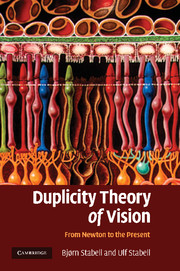Book contents
- Frontmatter
- Contents
- Acknowledgements
- 1 Introduction
- Part I The development of the basic ideas of the duplicity theory from Newton to G. E. Müller
- Part II The development of the duplicity theory from 1930–1966
- Part III Chromatic rod vision: a historical account
- Part IV Theories of sensitivity regulation of the rod and cone systems: a historical account
- 15 Introduction
- 16 Early photochemical explanations
- 17 Contribution of S. Hecht
- 18 Contribution of G. Wald: photochemical sensitivity regulation mechanisms of rods and cones
- 19 Relationship between amount of rhodopsin and sensitivity during dark adaptation
- 20 Post-receptor sensitivity regulation mechanisms
- 21 Rushton's AGC model
- 22 Contribution of H.B. Barlow
- 23 Rushton and Barlow compared
- 24 The Dowling-Rushton equation refuted
- 25 Several mechanisms involved in sensitivity regulation
- 26 Sensitivity regulation due to rod-cone interaction
- 27 Modern conceptions of sensitivity regulation
- Part V Factors that triggered the paradigm shifts in the development of the duplicity theory
- References
- Index
16 - Early photochemical explanations
Published online by Cambridge University Press: 22 January 2010
- Frontmatter
- Contents
- Acknowledgements
- 1 Introduction
- Part I The development of the basic ideas of the duplicity theory from Newton to G. E. Müller
- Part II The development of the duplicity theory from 1930–1966
- Part III Chromatic rod vision: a historical account
- Part IV Theories of sensitivity regulation of the rod and cone systems: a historical account
- 15 Introduction
- 16 Early photochemical explanations
- 17 Contribution of S. Hecht
- 18 Contribution of G. Wald: photochemical sensitivity regulation mechanisms of rods and cones
- 19 Relationship between amount of rhodopsin and sensitivity during dark adaptation
- 20 Post-receptor sensitivity regulation mechanisms
- 21 Rushton's AGC model
- 22 Contribution of H.B. Barlow
- 23 Rushton and Barlow compared
- 24 The Dowling-Rushton equation refuted
- 25 Several mechanisms involved in sensitivity regulation
- 26 Sensitivity regulation due to rod-cone interaction
- 27 Modern conceptions of sensitivity regulation
- Part V Factors that triggered the paradigm shifts in the development of the duplicity theory
- References
- Index
Summary
A first clue to an understanding of the sensitivity regulation mechanism in rods was given by the discovery by Boll in 1876 that the photopigment rhodopsin, situated in the outer segment of the rod receptors, was bleached by light and regenerated in the dark. He also showed that the bleaching effect of light depended on the wavelength used (Boll, 1878).
Influenced by this great discovery, Kühne, in an extensive research work, provided strong evidence in favour of the view that the sensitivity difference between rods and cones had a photochemical basis (Kühne, 1877a, b, 1877–1878, 1879). He investigated the bleaching and regeneration processes of rhodopsin in much more detail than Boll and made an important theoretical contribution with his influential ‘Optochemische’ hypothesis, where he presumed that the phototransduction in both rods and cones was photochemical in nature. Accordingly, he presumed that the apparent colourless cone receptors contained photochemical substances, and that these substances became involved in visual processing under daylight conditions. Indeed, in opposition to Schultze's (1866) duplicity theory, he presumed that even rods were activated by photochemical, colourless substances in daylight.
Furthermore, Kühne (1879) made an important distinction between the photochemical substances and their photoproducts, and argued that it was the photoproducts, not the photosensitive substances that generated the neural activity in the retina. Moreover, he discovered that rhodopsin may regenerate in two quite different ways: a rapid anagenese from photoproducts of rhodopsin and a slower neogenese from new substances formed after rhodopsin had been bleached.
- Type
- Chapter
- Information
- Duplicity Theory of VisionFrom Newton to the Present, pp. 133 - 134Publisher: Cambridge University PressPrint publication year: 2009



